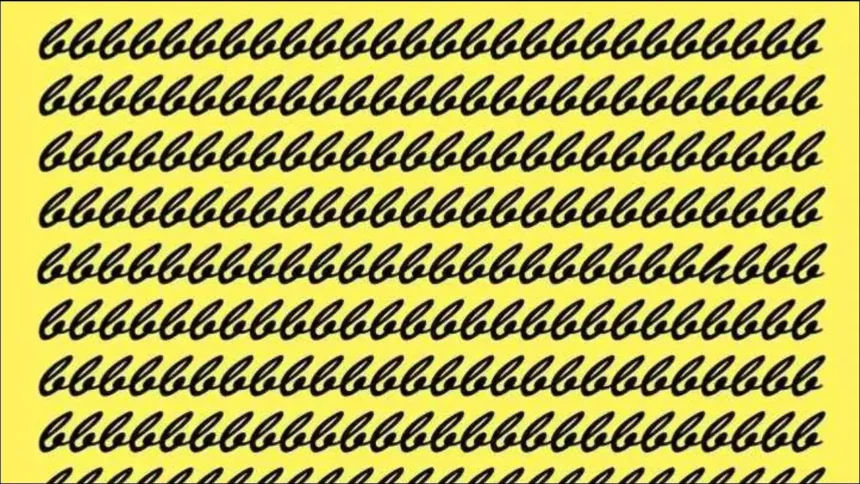Optical illusions have long fascinated humanity, challenging our perceptions and cognitive abilities.
They serve as intriguing tools not only for entertainment but also for testing and understanding the intricacies of the human mind.
Among the myriad of optical illusions circulating the internet, one particular challenge has captured the attention of many – the quest to spot the number 94 hidden among a grid of 64 seemingly identical digits.
This seemingly simple task has been touted as a test of observational prowess and intelligence, with claims that only 1% of people possess the ability to spot the elusive number within a mere 9 seconds.
But what lies behind this optical illusion, and what does it truly reveal about our cognitive abilities?
Understanding Optical Illusions

Before delving into the specifics of the challenge, it’s essential to grasp the nature of optical illusions.
These visual phenomena occur when our brains interpret images in a way that doesn’t match reality. Our perception is influenced by various factors, including contrast, color, depth, and motion, which can trick us into seeing something that isn’t actually there.
Optical illusions exploit these cognitive biases, often leading us to perceive shapes, colors, or patterns differently from how they truly appear.
The Challenge: Spotting the Number 94
The challenge at hand presents participants with a grid consisting of 64 randomly arranged digits, typically ranging from 0 to 9.
Amidst this sea of numbers lies the elusive combination – 94 – hidden in plain sight.
The objective is to identify this specific sequence within a strict time limit of 9 seconds.
Sounds simple enough, right? However, the arrangement of the digits, coupled with the time constraint, makes this task deceptively difficult.
The Difficulty of the Task
At first glance, the grid appears uniform, with no discernible pattern or anomaly.
This deliberate design choice is intended to confound participants and enhance the challenge’s difficulty.
Our brains are wired to seek patterns and familiar shapes, but the random arrangement of digits disrupts this process, leading to confusion and frustration for many.
Moreover, the time limit adds a sense of urgency, placing pressure on participants to quickly scan the grid for any signs of the elusive number combination.
This time constraint not only tests one’s observational skills but also their ability to process information rapidly under stress.
The Psychological Aspect
Beyond its surface-level entertainment value, this optical illusion taps into deeper psychological phenomena.
Our brains are remarkably adept at filtering out irrelevant information to focus on what’s deemed important.
In the context of this challenge, our attention is directed towards locating the number 94 while disregarding the surrounding distractions.
Furthermore, the illusion highlights the concept of inattentional blindness – the phenomenon where individuals fail to notice unexpected stimuli in their field of vision due to focusing on a primary task.
As participants fixate on finding the elusive number combination, they may overlook other digits or patterns that could aid them in their quest.
The Role of Observational Skills and Intelligence
The claim that only 1% of people can spot the number 94 within the allotted 9 seconds suggests a correlation between observational skills and intelligence.
Observational skills encompass the ability to perceive and process visual information accurately and efficiently.
Highly observational individuals excel at noticing subtle details and patterns that others might overlook.
Intelligence, on the other hand, is a multifaceted construct that encompasses various cognitive abilities, including problem-solving, critical thinking, and memory.
While observational skills are undoubtedly a component of intelligence, they do not solely determine one’s intellectual capacity.
The notion that only a select few possess the ability to complete the challenge within the specified time frame raises questions about the validity of such claims.
Intelligence is a complex and nuanced trait influenced by genetics, environment, and individual experiences.
While some individuals may excel at visual tasks, others may demonstrate their intelligence through different avenues.
The Illusion of Difficulty
It’s essential to approach challenges like the “spot the number 94” task with a critical mindset.
While it may indeed pose a considerable challenge for some, its difficulty is not necessarily indicative of one’s intelligence.
Optical illusions exploit cognitive biases and perceptual limitations to create the illusion of complexity.
Additionally, the subjective nature of intelligence complicates any blanket assertions regarding who can or cannot complete the challenge.
Intelligence manifests in various forms, and a person’s ability to solve visual puzzles may not necessarily reflect their overall cognitive abilities.
Practical Implications
Despite the inherent subjectivity of tasks like the “spot the number 94” challenge, they serve as valuable tools for stimulating critical thinking and problem-solving skills.
Engaging with optical illusions encourages individuals to question their perceptions and think outside the box. Moreover, they can be utilized in educational settings to promote visual literacy and cognitive flexibility.
Conclusion
The optical illusion of spotting the number 94 among a grid of 64 digits is a captivating yet challenging task that has garnered widespread attention.
While its difficulty may frustrate some, it serves as a testament to the complexities of human perception and cognition.
The claim that only 1% of individuals possess the observational skills necessary to complete the challenge within 9 seconds underscores the interplay between visual processing and intelligence.
However, it’s crucial to approach such tasks with a critical mindset and recognize that intelligence encompasses far more than the ability to solve visual puzzles.
Ultimately, optical illusions like this one provide valuable insights into the workings of the human mind and offer opportunities for intellectual stimulation and growth.

